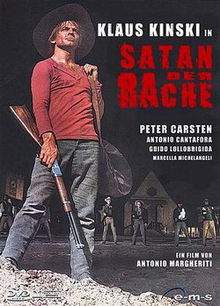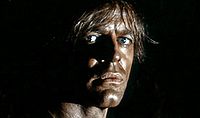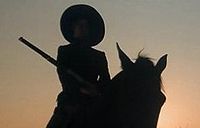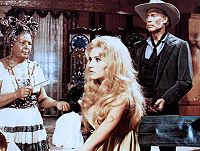And God said to Cain Review

|
| AND GOD SAID TO CAIN 1969 |
Cast:
Director:
|
And God said to Cain (E Dio disse a Caino)

|
After ten years of forced labour, for a crime he didn't commit, Gary Hamilton (Klaus Kinski) is pardoned. He was framed by his former friend Acombar, who is now maried to Gary's former girlfriend Maria. In the mean time Acombar has become a local tyrant, with an army of gunmen to protect him. On the stagecoach Hamilton accidently meets Acombar's son Dick and asks the boy to tell his father about his arrival. A tornado is announced and when Hamilton approaches town, and the gunmen who are waiting for him are blinded by the dust raised by the heavy winds. Hamilton uses the network of underground galleries (from an Indian graveyard) to stalk his enemies and kill them one by one, helped by some of the town's people who hate Acombar.
Often called Margheriti's best western, as well as one of the very best of the gothic spaghetti westerns, this is also a controversial movie. It's an unofficial 'remake' of another spaghetti western, made only months earlier, Salvatore Rosso's A Stranger in Paso Bravo. Although some story elements were changed, the similarities cannot be denied or simply called coincidental, the more so because in Rosso's film Anthony Steffen plays an avenger called Gary Hamilton, while his nemesis, played by Eduardo Fajardo, is called Acombar. In his Dizionario Giusti calls it a near miracle that Margheriti wasn't sued for plagiarism. Maybe the possiblility of a legal procedure was the reason for Margheriti to practically disown his movie for most part of his life. As we shall see plagiarism doesn't necessarily imply a lack of creativity.

|

|
In And God said to Cain Margheriti further developed some ideas already used in his previous western, Vengeance. While in that movie the horror aspects were still rather restrained, we start to doubt during this movie whether Kinski's character is a man or a ghost. In the first half hour, when his character is developed, we see Kinski gradually degenerating into a creature possessed by a craving for revenge, and when he finally arrives at the gates of Acombar Town (in the best sequence of the movie and a truly brilliant scene), he is no more than a shadow, a figure silhouetted against the horizon. In the next scene only his horse rides into town, as if the man has been swallowed by the howling winds. In true horror style, excellent use has been made of slamming windows, flapping curtains and tolling bells to create an atmosphere of terror and imminent danger. Birds start screaming when Hamilton's name is called ...
Another aspect that is pushed further here than in Margheriti's previous western, is the depiction of violence. The famous opening scene of Vengeance, in which a man is about to be quartered, is frightening, but in a suggestive, not exploitative way. But in this film a priest is executed, slowly and deliberately, in front of an immobile camera, and one of the villains is literally crushed by a giant bell, in probably the most graphically violent scene you'll ever see in a spaghetti western. Margheriti also called his own film 'more Sicilian than American': with a script about betrayal and the strength of family ties, it is closer to a mafia story than a typical story set in the West. When Acombar's son, who seems a decent and mild-tempered person throughout the movie, finds out that his beloved and seemingly respectable father is a criminal, he still chooses his side, referring to the strong feelings of loyalty with the clan and the family, that lie at the base of Italian crime rings's existence. In agreement with the classical family drama, it's the father, the patriarch, who finally causes the downfall of the dynasty by killing his own successor by mistake.
By cutting all superfluous dialogue and story elements from Salvatore Rosso's movie, that served as a model, Margheriti has managed to make a nearly completely original spaghetti western, cold, frightning, bloody, beautiful. It respects the classic dramatic unities of time, place and action, as derived from Aristotle's Poetics: the story isn't concerned with sub-plots, is mainly set in one place, and unfolds within one terrible, stormy night. Probably only a director with a history in horror could come up with the idea of casting Kinski as a hero, albeit a hero who doesn't look his enemies in the eye but stalks them and doesn't even hesitate to shoot them in the back. According to his own son Edouardo, Antonio Margheriti wasn't a easy man to work with, which means there were at least two sunnava... on the set: "When they were filming in the tunnels, Kinski had one of his 'primadonna' attacks and was about to leave the set. Antonio was outraged and started to shout at him, finally even threw one of the guns that were used on the set at him. Strange as it may sound, with this gesture Antonio won Kinski's respect: he turned round, smiled and finished his job without problems" (1). As you might guess, Kinski turns in a wonderful, almost hypnotic performance. Is there any actor who could impersonate a possessed avenger better than Klaus? Familiar with more extrovert heavies like Sancho or Fajardo, most temporary critics weren't happy with (co-producer) Carsten as Acombar, but in retrospect his subdued performance serves the film pretty well. Marcella's Michelangeli's part as the woman who betrayed her lover to live with his corrupt friend, is a little underwritten. Another let-down is the film's finale, a rather predictable homage to Orson Welles' mirror scene in The Lady from Shanghai. Otherwise this is a magnificent western. Allegedly Clint Eastwood was inspired by the dark, haunting look of the film for his oscar winning Unforgiven.
Corresponding Review: A Stranger in Paso Bravo Review
Note:
--By Scherpschutter
Page design by courtesy of dicfish



